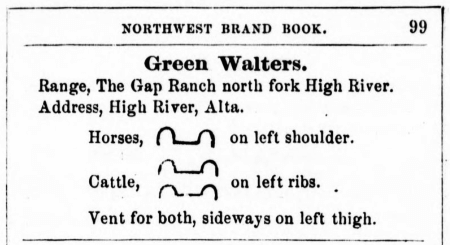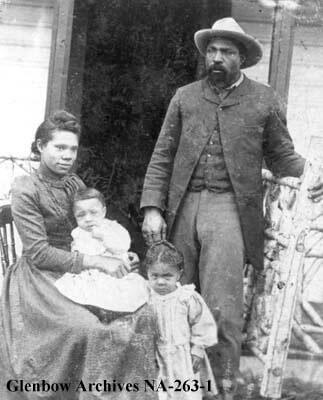Bertrand Bickersteth's research into cattle brands created by Black cowboys inspires a new poetry project
Athabasca University writer in residence Bertrand Bickersteth is shining a light on the untold history of Black cowboys and their overlooked yet pivotal role in shaping the culture of Alberta and the broader Western frontier.
For Bickersteth, this exploration of Black cowboy history is intertwined with issues of historical erasure, racial identity, and the complexities of belonging.
During his first talk as AU's writer in residence on Nov. 20, Bickersteth reflected on his upbringing. His parents were raised in colonial Sierra Leone, and shortly after he was born, they immigrated to Alberta. As he grew up and struggled to feel like he belonged, Bickersteth withdrew from his parents' culture.
Years later while living abroad, he experienced an unanticipated and intimate familiarity with British culture. While singing a British nursery rhyme to his son in England, he realized his parents had sung the same song to him as a boy in Alberta.
"I had a feeling of belonging in the U.K. that I had never experienced when I was in Alberta," said Bickersteth, who now calls Calgary home. "What I had thought was my parents' weirdness was actually just England."
This personal revelation of these contradictory emotions "feels like an important paradox to consider when it comes to Black belonging on the Prairies," he said.
Bickersteth's research into Black cowboy history and culture has informed his work as a writer and poet. His interest in cattle brands created by Black cowboys is inspiring a new poetry project that looks at how Black cowboys felt "at home" as cowboys, but at the same time "far from home" as Black immigrants in Canada.
Who is a cowboy?
The iconic image of the cowboy, as popularized in film, TV, literature, music, and folklore, contributed to the whitening of the West, he said. Black cowboys existed in the West, but they were invisible.
John Ware, a key figure in Bickersteth's research, is evidence of this whitening. Ware was a Black cowboy who worked on the historic Bar U Ranch in Alberta's foothills in the late 19th and early 20th centuries. Although he is considered a touchstone for Alberta Black history, he is equally unfamiliar to many.
"I call him the most famous unknown person we have," said Bickersteth.
Uncovering forgotten Black history
Bickersteth's research into Black cowboy culture and history is both time-consuming and emotionally taxing. The work requires sifting through fragments of records and piecing together stories from limited resources such as old newspapers.
Poring over records that recall racism and historical injustices is also disheartening. For Bickersteth, the epitome of this toll is the recognition that branding was applied to humans, and he referenced documentation directing how Black slaves were to be branded before being transported between British colonies.
Fortunately, Bickersteth said the value of what he has recovered makes the process worth it. And what he is recovering through cattle brands is what he calls the "lost language of Black cowboys."
"There are happy discoveries. Just a couple of weeks ago, I found a couple more cattle brands. I'm thrilled to have found those."
Black cowboys of Alberta and their brands
For Bickersteth, these cattle brands are more than marks of ownership, they are forms of personal and creative expression.
Charles Dyson was a Black rancher and a blacksmith, suggesting that he likely forged his own branding iron. For this reason, Bickersteth considers Dyson a poet.
"I feel as though he is actually engaging in a kind of language," he said. "He invented that symbol, then he created it, and then registered it."
Among the other Black cowboy brands registered in Alberta's Brand Book are John Ware's four nines, sometimes referred to as the walking stick brand, and Green Walters' double ox yoke design.
Walters, who worked as a cook and general ranch hand, eventually started his own small ranch and a cattle brand to go along with it.
"This is poetry, because you can't help but connect that language, the yoke, to imagery of slavery."

Reclaiming history through poetry
Bickersteth's goal of his poetry project is to create a new font that incorporates the cattle brands of Black cowboys such as Ware, Walters, and Dyson. With this new font, which he plans to make freely available, he will create a series of poems.
By giving a voice to the experiences of Black cowboys, Bickersteth is helping to create a more accurate and inclusive historical record.
We don't see many Black cowboys today because we believe that there were none in the past. The more we bring this past out, the more viable it will be for people to return to this sort of thing as well.
Get writing advice from AU's writer in residence
The Athabasca University Writer in Residence program, housed in and supported by the Faculty of Humanities and Social Sciences, has introduced students, faculty, and the wider community to exceptionally talented authors since it's inception in 2009.
With support from the Canada Council for the Arts, Bickersteth's term as AU's writer in residence runs until June 2025.
He is available for one-on-one consultations with creative writers who are looking for personalized feedback on their work.
AU students and community members are encouraged to submit their work for feedback.
A university Like No Other
Athabasca University is a university like no other, uniquely focused on the core priorities of access, community, and opportunity.
